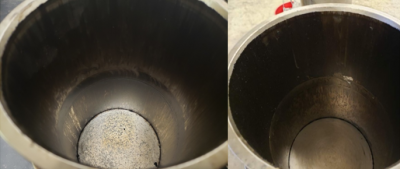“My boss is always on my case to keep the molds clean. They’re a pain! Does it really matter?”
Yes, clean molds and end plates matter. If your molds look like the ones below, you have some work to do.

Figure 1: Dirty Molds.
Required for Certification
A proper annual verification/calibration of a gyratory compactor includes checking the mold assembly(s). And to check them, requires that they be clean. Not only does the standard require them to be clean, they must be clean to receive an accurate measurement.
AASHTO T312 Section A1.1 states “Minimum frequency of this evaluation [the evaluation of the molds as a check for compliance] is 12 months or 80 hours of operation.”
AASHTO T312 Section A3.1.1 states in part “Confirm that molds are thoroughly cleaned” and Section A3.1.2 states in part “The mold bore shall be free of residue …”
Molds are measured to one thousandth of a millimeter. That is a resolution of 0.001 mm. They are required to have an inside diameter from 149.90 to 150.20 mm measured at three locations along the bore (AASHTO T312 Annex A).
Properly cleaning molds can require much time and effort. But, taking a few minutes after each use to remove debris and asphalt binder from the mold and end plates is a good investment. It will prevent a much greater exertion of effort to remove binder that has been baked on over time.
End Plate Binding
A buildup of asphalt binder on the mold and mold endplates reduces the available space between them and increases the friction resistance of the surface. Occasionally customers call Pine because they are having a problem with their gyratory compactor only to learn that the end plate is binding in the mold because the molds weren’t properly maintained. A thorough cleaning of the endplate and mold resolves the problem.
What Does Pine Recommend?
Clean molds and end plates matter! Help yourself by applying the following recommendations:
- Pine Service Technicians use two products to clean and maintain molds – WD40 and Purple Power. Always read the product Safety Data Sheet before opening a cleaning product. Wear gloves and safety glasses when using these products.
- WD-40 works well as a general, daily-use product. It cleans and protects the molds from rust.
- Purple Power cleaner/degreaser is tough on built-up asphalt cement. In the event of mild to severe asphalt cement build-up, soak the mold in a bucket of Purple Power overnight. The residue will soften and wipe away with amazing results. After cleaning a mold with Purple Power, apply a coat of WD40 to keep the mold from rusting.
- Use hand razor-blade paint scrapers to remove a thin layer of build-up. Angle the scraper and rock it back and forth in the mold. Use caution to not scratch the bore of the mold.
- Do NOT use a wire brush or wheel. It will scratch the mold and increase the bore diameter. Remember molds are measure to 0.001 mm.
- Do NOT superheat the molds to “burn off” the residue. Molds are heat treated in a way that makes them resistant to temperature change. Extreme heat beyond the normal asphalt range can change the molecular structure of the steel and cause it to swell or warp.
Want to learn more?
Talk with one of our specialists at 724-458-6393.



